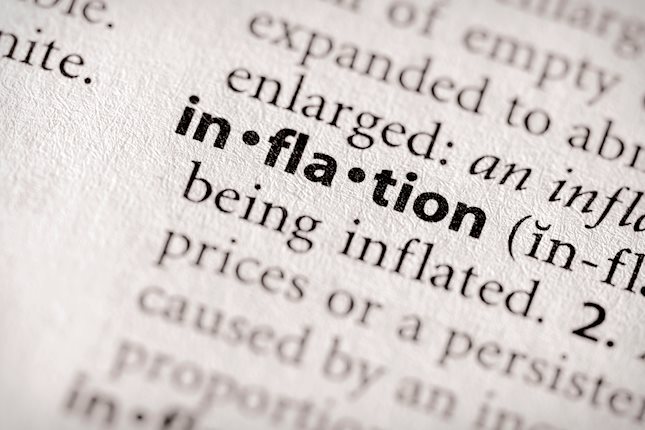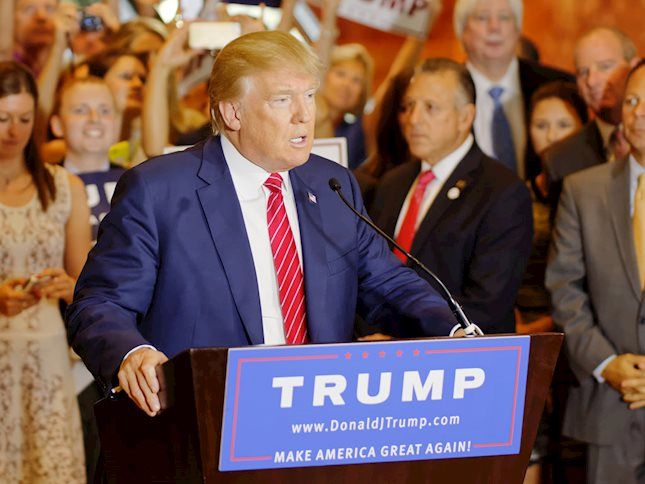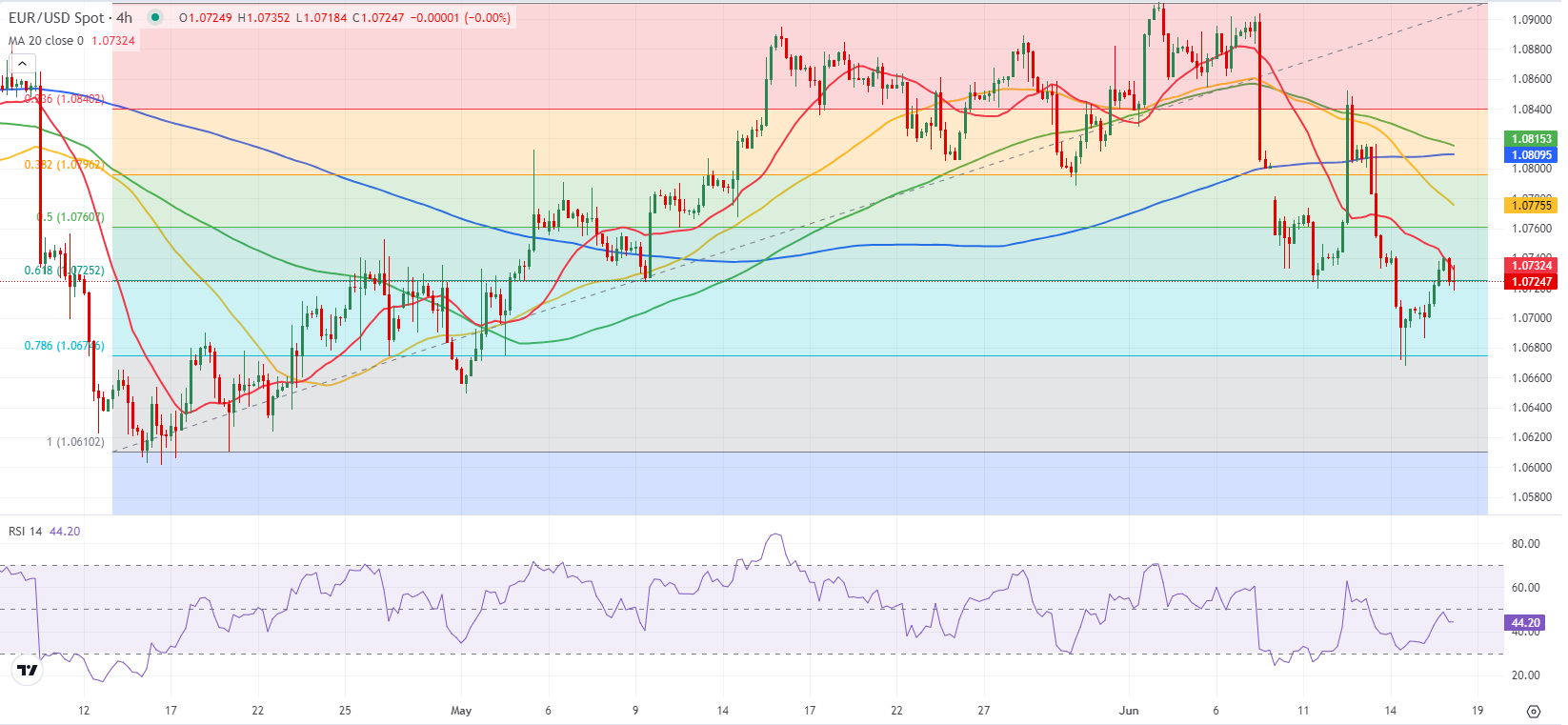- EUR/USD holds steady above 1.0700 after posting gains on Monday.
- The pair could stretch higher in case risk flows dominate the action in financial markets.
- US economic docket will feature Retail Sales data for May.
After struggling to gain traction in the first half of the day on Monday, EUR/USD turned north in the American session and closed in positive territory. The pair stays relatively quiet early Tuesday and fluctuates in a tight channel above 1.0700.
Euro PRICE This week
The table below shows the percentage change of Euro (EUR) against listed major currencies this week. Euro was the strongest against the New Zealand Dollar.
| USD | EUR | GBP | JPY | CAD | AUD | NZD | CHF | |
|---|---|---|---|---|---|---|---|---|
| USD | -0.18% | 0.05% | 0.47% | 0.00% | -0.03% | 0.49% | -0.20% | |
| EUR | 0.18% | 0.25% | 0.68% | 0.21% | 0.06% | 0.72% | -0.02% | |
| GBP | -0.05% | -0.25% | 0.52% | -0.04% | -0.21% | 0.43% | -0.25% | |
| JPY | -0.47% | -0.68% | -0.52% | -0.35% | -0.49% | 0.16% | -0.61% | |
| CAD | -0.01% | -0.21% | 0.04% | 0.35% | -0.10% | 0.49% | -0.19% | |
| AUD | 0.03% | -0.06% | 0.21% | 0.49% | 0.10% | 0.72% | -0.04% | |
| NZD | -0.49% | -0.72% | -0.43% | -0.16% | -0.49% | -0.72% | -0.68% | |
| CHF | 0.20% | 0.02% | 0.25% | 0.61% | 0.19% | 0.04% | 0.68% |
The heat map shows percentage changes of major currencies against each other. The base currency is picked from the left column, while the quote currency is picked from the top row. For example, if you pick the Euro from the left column and move along the horizontal line to the US Dollar, the percentage change displayed in the box will represent EUR (base)/USD (quote).
In the absence of high-tier data releases, the positive shift seen in risk mood, as reflected by rising US stocks, made it difficult for the US Dollar (USD) to find demand in the American session and provided a boost to the pair.
Early Tuesday, the Euro Stoxx 50 Index is up more than 0.5% and US stock index futures trade marginally higher on the day.
In the second half of the day, the US Census Bureau will release Retail Sales data for May. Markets expect a monthly increase of 0.2%. A bigger-than-expected growth could support the USD with the immediate reaction, while a negative print could weigh on the currency and help EUR/USD stretch higher.
Investors will continue to pay close attention to risk perception. A bullish opening in Wall Street, followed by an extended rally, could hurt the USD.
During the American trading hours, several Federal Reserve policymakers will be delivering speeches. In case officials continue to push back against the market expectation for a policy pivot in September, the USD could stay resilient and limit EUR/USD's upside.
EUR/USD Technical Analysis
The Relative Strength Index (RSI) indicator on the 4-hour chart stays below 50, suggesting that the pair is yet to gather bullish momentum. In case the pair manages to hold above .10730, where the Fibonacci 61.8% retracement of the latest uptrend is located, 1.0760 (Fibonacci 50% retracement) and 1.0800 (Fibonacci 38.2% retracement) could be seen as next resistance levels.
On the downside, 1.0670 (Fibonacci 78.6% retracement) aligns as key support before 1.0600 (beginning point of the uptrend).
Euro FAQs
The Euro is the currency for the 20 European Union countries that belong to the Eurozone. It is the second most heavily traded currency in the world behind the US Dollar. In 2022, it accounted for 31% of all foreign exchange transactions, with an average daily turnover of over $2.2 trillion a day. EUR/USD is the most heavily traded currency pair in the world, accounting for an estimated 30% off all transactions, followed by EUR/JPY (4%), EUR/GBP (3%) and EUR/AUD (2%).
The European Central Bank (ECB) in Frankfurt, Germany, is the reserve bank for the Eurozone. The ECB sets interest rates and manages monetary policy. The ECB’s primary mandate is to maintain price stability, which means either controlling inflation or stimulating growth. Its primary tool is the raising or lowering of interest rates. Relatively high interest rates – or the expectation of higher rates – will usually benefit the Euro and vice versa. The ECB Governing Council makes monetary policy decisions at meetings held eight times a year. Decisions are made by heads of the Eurozone national banks and six permanent members, including the President of the ECB, Christine Lagarde.
Eurozone inflation data, measured by the Harmonized Index of Consumer Prices (HICP), is an important econometric for the Euro. If inflation rises more than expected, especially if above the ECB’s 2% target, it obliges the ECB to raise interest rates to bring it back under control. Relatively high interest rates compared to its counterparts will usually benefit the Euro, as it makes the region more attractive as a place for global investors to park their money.
Data releases gauge the health of the economy and can impact on the Euro. Indicators such as GDP, Manufacturing and Services PMIs, employment, and consumer sentiment surveys can all influence the direction of the single currency. A strong economy is good for the Euro. Not only does it attract more foreign investment but it may encourage the ECB to put up interest rates, which will directly strengthen the Euro. Otherwise, if economic data is weak, the Euro is likely to fall. Economic data for the four largest economies in the euro area (Germany, France, Italy and Spain) are especially significant, as they account for 75% of the Eurozone’s economy.
Another significant data release for the Euro is the Trade Balance. This indicator measures the difference between what a country earns from its exports and what it spends on imports over a given period. If a country produces highly sought after exports then its currency will gain in value purely from the extra demand created from foreign buyers seeking to purchase these goods. Therefore, a positive net Trade Balance strengthens a currency and vice versa for a negative balance.
Information on these pages contains forward-looking statements that involve risks and uncertainties. Markets and instruments profiled on this page are for informational purposes only and should not in any way come across as a recommendation to buy or sell in these assets. You should do your own thorough research before making any investment decisions. FXStreet does not in any way guarantee that this information is free from mistakes, errors, or material misstatements. It also does not guarantee that this information is of a timely nature. Investing in Open Markets involves a great deal of risk, including the loss of all or a portion of your investment, as well as emotional distress. All risks, losses and costs associated with investing, including total loss of principal, are your responsibility. The views and opinions expressed in this article are those of the authors and do not necessarily reflect the official policy or position of FXStreet nor its advertisers. The author will not be held responsible for information that is found at the end of links posted on this page.
If not otherwise explicitly mentioned in the body of the article, at the time of writing, the author has no position in any stock mentioned in this article and no business relationship with any company mentioned. The author has not received compensation for writing this article, other than from FXStreet.
FXStreet and the author do not provide personalized recommendations. The author makes no representations as to the accuracy, completeness, or suitability of this information. FXStreet and the author will not be liable for any errors, omissions or any losses, injuries or damages arising from this information and its display or use. Errors and omissions excepted.
The author and FXStreet are not registered investment advisors and nothing in this article is intended to be investment advice.
Recommended Content
Editors’ Picks

EUR/USD stays vulnerable near 1.0600 ahead of US inflation data
EUR/USD remains under pressure near 1.0600 in European trading on Wednesday. The pair faces headwinds from the US Dollar upsurge, Germany's political instability and a cautiou market mood, as traders look to US CPI data and Fedspeak for fresh directives.

GBP/USD trades with caution below 1.2750, awaits BoE Mann, US CPI
GBP/USD trades with caution below 1.2750 in the European session on Wednesday, holding its losing streak. Traders turn risk-averse and refrain from placing fresh bets on the pair ahead of BoE policymaker Mann's speech and US CPI data.

Gold price holds above $2,600 mark, bulls seem non committed ahead of US CPI
Gold price staged a modest recovery from a nearly two-month low touched on Tuesday. Elevated US bond yields and bullish USD cap gains for the non-yielding XAU/USD. Traders now look forward to the key US Consumer Price Index report a fresh impetus.

US CPI data set to confirm inflation ramped up in October as traders pare back Fed rate cut bets
As measured by the CPI, inflation in the US is expected to increase at an annual rate of 2.6% in October, a tad higher than the 2.4% growth reported in September. The core annual CPI inflation, excluding volatile food and energy prices, will likely remain at 3.3% in the same period.

Forex: Trump 2.0 – A high-stakes economic rollercoaster for global markets
The "Trump trade" is back in full force, shaking up global markets in the aftermath of the November 5th U.S. election. This resurgence has led to substantial shifts in both currency and bond markets, with the U.S. dollar index (DXY) jumping 2.0% + since election day.

Best Forex Brokers with Low Spreads
VERIFIED Low spreads are crucial for reducing trading costs. Explore top Forex brokers offering competitive spreads and high leverage. Compare options for EUR/USD, GBP/USD, USD/JPY, and Gold.
